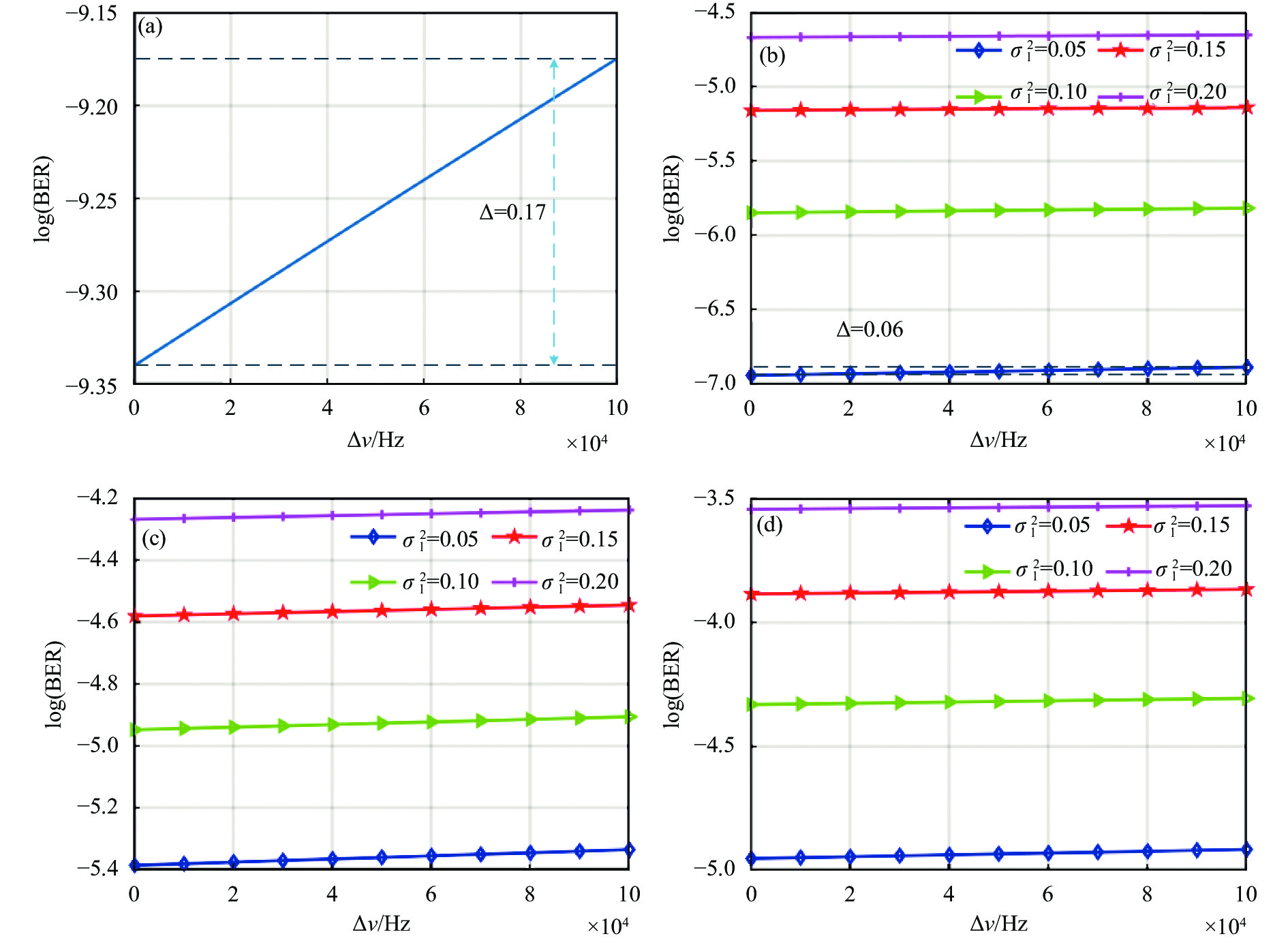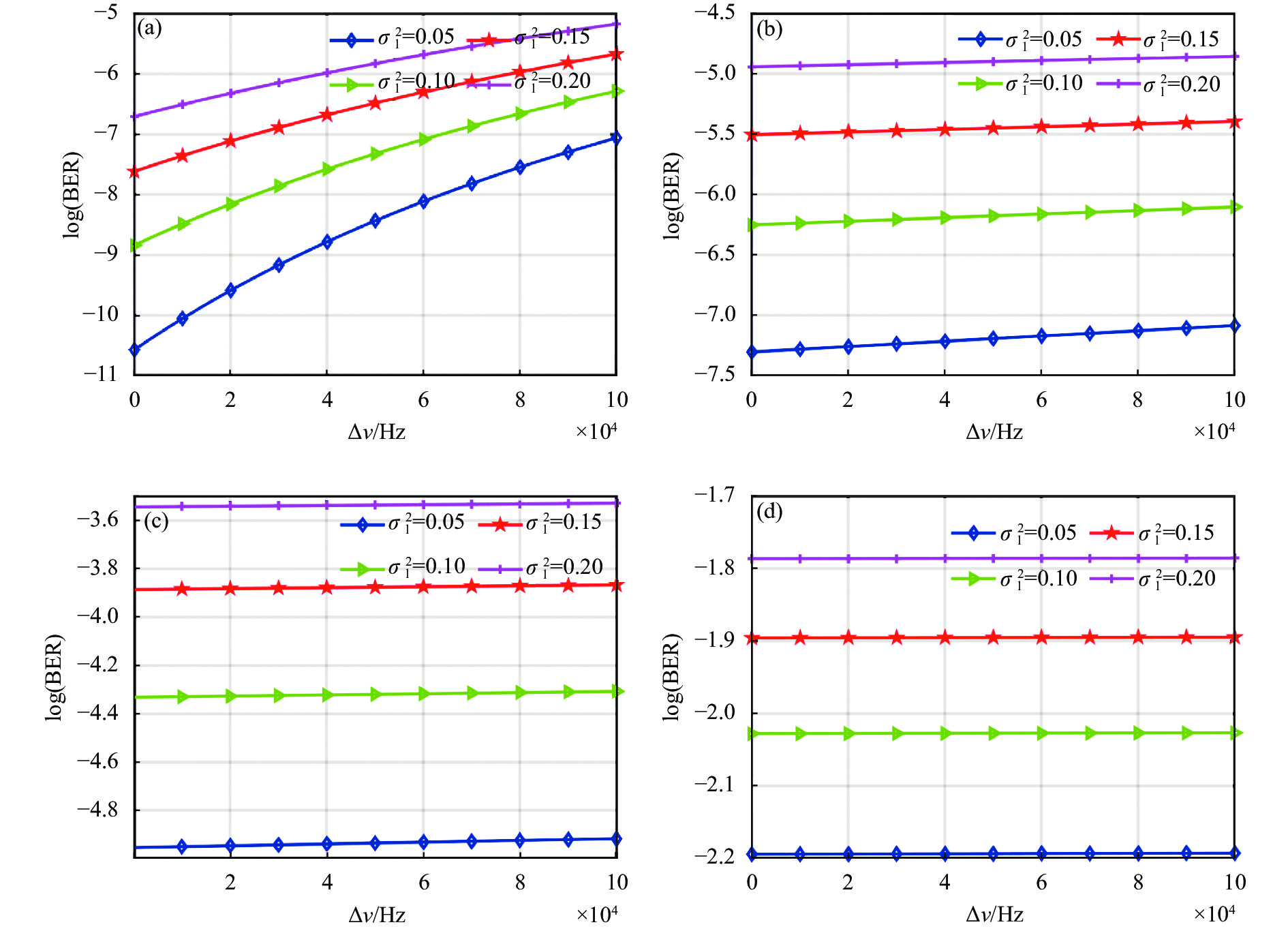-
自由空间光通信与微波通信相比,具有通信速度快、通信容量大和功耗小等优势[1-3]。相干激光调制技术是光调制技术的一种,与强度调制/直接检测不同,相干调制技术不仅调制了光信号的振幅,还调制了光信号的相位,因而光信号能携带更多的信息,减小了系统带宽,并且能有效提升接收机灵敏度[4]。这使得相干激光通信技术有很大的应用前景, 空间相干激光通信系统已经得到了初步的应用[5]。
虽然空间光通信技术和微波通信技术相比有很多优势,但光信号在大气信道中传输时会受到大气湍流的影响,光信号质量下降,因而空间光通信系统的性能也会随之降低,特别是在长距离范围内,极大地限制了其广泛应用[2, 6]。大气湍流是由于大气介质的非均匀性以及大气环境中的温度、压强和风速等随时间和空间的变化而形成一种涡旋[7]。在空间相干激光通信系统中,光信号在大气中传输时,会受到大气湍流的影响,主要体现在大气湍流引起的接收光信号强度波动和相位波动[8],这些会极大降低通信系统的性能。
由于空间相干激光通信具有更大的优势,研究者对空间相干激光通信展现了浓厚兴趣[9-12]。Jokhakar J D 等分析了大气闪烁、温度、气压和发射功率对四相移键控(Quadri Phase Shift Keying, QPSK)自由空间光学地球同步卫星通信性能的影响[13],但是他们只考虑了大气的损耗,而没有考虑大气湍流引起的接收光信号的强度波动和相位波动,此外,也没有考虑激光器的线宽因素。Kong Y X等研究了大气湍流影响下激光器线宽对系统误码率的影响,分析了不同湍流强度、不同链路长度和不同中频频率影响下激光器线宽对误码率的影响[14],但是他们的大气信道模型是地面水平大气信道,空间下行大气湍流模型更加复杂,与水平的大气湍流模型有很大的不同。Li Y等研究了不同发射功率、接收孔径以及束散角对大气湍流影响下空间下行相干激光通信误码率的影响[15],然而他们没有考虑大气湍流引起的光信号相位波动以及激光器线宽对系统性能的影响。此外,研究者们还对大气湍流影响下光束传输特性做了一定的研究和阐述[16-17]。 上述工作研究了大气湍流强度、发射功率、通信链路以及激光器线宽等因素对空间相干激光通信系统性能的影响,但没有考虑窄线宽激光器情况下系统性能。另外,之前的研究者们大多在研究空间下行相干激光通信系统性时,不少研究者们忽略了大气湍流引起的相位波动。
文中基于QPSK通信系统的工作原理,考虑到窄线宽激光器的相位噪声、大气湍流引起的光信号强度和相位波动,得到空间下行QPSK通信系统误码率模型。基于该模型,分析和讨论了在不同大气湍流下窄线宽激光器对空间下行相干激光通信系统性能影响,进一步分析了不同通信速率下不同大气湍流的窄线宽激光器对空间下行相干激光通信系统性能影响。文中结果对空间下行激光通信系统的优化设计具有一定的参考价值。
-
大气湍流下空间下行相干激光通信的系统如图1所示。在信号的调制下,激光器LD1输出的激光经过正交调制器(In-phase and Quadrature Modulator, IQ Mod)后,成为光QPSK信号s1(t)。然后,光QPSK信号s1(t)由掺铒光纤放大器(Erbium Doped Optical Fiber Amplifier, EDFA)放大,最后由发射端将光QPSK信号发射进入到大气信道。在接收端,光QPSK信号被接收之后,与激光器LD2产生的本振光进行相干混频,混频之后进入平衡探测器进行光电转换和滤波,消去高频分量,得到光电流信号I(t)。然后,电流信号I(t)进入IQ解调模块,信号中的同向(In-phase, I)和正交(Quadrature, Q)分量分别与载波cos(wIF)和−sin(wIF)相乘。下一步I分量和Q分量信号经过低通滤波,进入数字信号处理器(Digital Signal Processor, DSP),获得发送信号的信息。
-
对于空间相干激光通信而言,信号主要在大气信道中传输,因此空间相干激光通信系统的通信性能不仅受到激光器线宽的影响,也会受到大气信道的影响。光信号在大气信道中传输时,主要受到大气湍流的影响。一方面,大气湍流会影响光信号的强度,从而造成接收端光信号强度波动;另一方面,大气湍流也会影响光信号的相位,从而造成接收端光信号相位波动。大气湍流和激光器线宽都会影响空间相干激光通信系统性能。
根据参考文献[4],相干激光通信接收端光电流可写成:
式中:Rd=ηqλ/hc表示平衡探测器的光电探测效率,其中η是平衡探测器的量子效率,q为元电荷,其大小为1.6021892×10−19C,h为普朗克常数,c为真空中的光速;α=αlossDr/2W 2表示接收端光信号的损耗,αloss是损耗因子,Dr为接收端接收镜头的孔径,W=W0+θL/2表示光信号在接收平面的光束半径,W0为发射端的光束半径,θ为光信号的束散角,L为光信号的传输距离;GEDFA表示发射端EDFA的增益系数;P1是发射端激光器LD1的输出功率;P2是接收端本振激光器LD2的功率,ωIF=|ωs−ω2|是信号光和本振光相干混频之后的中频频率,ωs是发射端信号激光器LD1的角频率,ω2是本振激光器LD2的角频率;θk表示QPSK通信系统的调制相位;
${\varphi _n} $ 表示激光器输出激光的相位波动,与由激光器的线宽有关,激光器输出激光的相位波动是一个维纳随机过程,输出相位可以写成[18]:式中:νi为一系列独立同分布高斯变量,其均值为0。方差
$ \sigma _\theta ^2 $ 可以写成[19]:式中:Δν为通信系统中激光器的总线宽;Baud为通信系统的波特率。
is(t)和iT(t)分别为平衡探测器的散粒噪声和热噪声,它们的噪声方差分别是
$\sigma _s^2= 2 q{I_p} \Delta f$ 和$\sigma _T^2 = $ ${{4 KT \Delta f} \mathord{\left/ {\vphantom {{4 KT \Delta f} {{R_L}}}} \right. } {{R_L}}} $ [20],其中Ip为平均光电流,Δf为平衡探测器的探测器带宽,K为玻耳兹曼常数,T为环境的绝对温度,RL为负载电阻,idc(t)为暗电流。在通信领域中,一般使用误码率(Bit Error Rate, BER)来衡量通信系统的性能。当光信号在大气信道中传输时,大气湍流不仅会影响光信号的强度分布,也会影响光信号相位。因此,在空间相干激光通信系统中,大气湍流会降低系统的误码率。一般来说,可以用平均误码率来描述空间相干激光通信系统的性能。
由于光信号受到大气湍流的影响,在接收端光信号的功率并不是固定的。对于高斯光束,不同接收光强I的概率密度Pr(I)可以表示为[21]:
式中:<I>表示接收端光信号的平均光强;
$ \sigma _I^2 $ 为接收端中心的光强闪烁方差[21],与大气折射率结构常数$ C_n^2\left( h \right) $ 有关,$ C_n^2\left( h \right) $ 是基于Hufnagel-Valley模型的大气折射率结构常数,其可表示为[22]:式中:h为距离地面的高度;C0为地表的折射率结构常数;v为垂直于光信号传输路径的风速。
光信号在大气信道中传输时,不仅光信号强度会受到大气湍流的影响,光信号相位也会受到大气湍流的影响,引起接收端光信号相位波动。在大气湍流的影响下,接收端光信号的相位服从零均值的高斯分布[23],其方差
$ \sigma _p^2 $ 与大气折射率结构常数$ C_n^2\left( h \right) $ 有关[8]。对于大气湍流而言,大气闪烁方差$ \sigma _I^2 $ 更能直观表示大气湍流的强度,并且$ \sigma _p^2 $ 也会随着大气闪烁方差$ \sigma _I^2 $ 的增加而增加,因此一般用大气湍流闪烁方差$ \sigma _I^2 $ 来表示大气湍流强度。在下文的分析中也采用了这种方式。因此,在大气湍流的影响下,空间下行相干激光通信接收端信号光电流可写成:
式中:Ps(I)为大气影响下接收端光信号功率;φp为大气湍流影响下接收端光信号的波动相位。
信号经过IQ解调后,在光电流信号I(t)进入DSP模块之前,信号分为同相信号Is(I)和正交信号Qs(I),分别可以写成如下形式:
式中:in(t)=is(t)+iT(t)+idc(t),表示系统中散粒噪声,热噪声和暗电流噪声的总和,称为系统的强度噪声。Ak(I)和Bk(I)为QPSK调制振幅,在QPSK调制中,调制信号的幅值是固定不变的,所以Ak(I)=Bk(I)。
可以得到空间下行相干激光通信系统的信噪比(signal-to-noise ratio, SNR)如下:
根据参考文献[24],采用QPSK调制的通信系统的误码率模型可以进一步写成:
由于空间下行相干激光通信系统受到大气湍流的影响,接收光信号的强度和相位存在波动,因此对QPSK调制下的通信系统误码率模型做了修改,可以使用系综平均的方法[25]将误码率模型修改为统计误码率模型<BER>可表示为:
-
在第1章节中,得到了空间下行空间相干激光通信系统的误码率模型。根据修正后的空间下行相干激光通信系误码率模型,分析了不同大气信道下空间下行相干激光通信系统中窄线宽激光器对误码率特性的影响。系统的仿真参数如表1所示。
Parameter Value Power of the transmitter laser LD1/mW 10 EDFA gain coefficient at the transmitter/dB 22 Loss coefficient αloss 1 Height of transmitting terminal H/km 36000 Height of receiving terminal h0/m 100 Central wavelength λ/nm 1550 Temperature T/K 300 Load resistance RL/Ω 50 Dark current idc(t)/nA 10 Communication rate/Gbps 2.5 Beam angle/rad 0 Beam divergence angle/μrad 30 Receiving aperture/m 0.1 Table 1. Parameters of space downlink coherent laser communication system
基于表1中的参数,首先分析了窄线宽激光器下不同大气湍流下空间下行相干激光通信系统的误码率,如图2(a)~(d)所示。为了解窄线宽激光器的激光器相位噪声对系统性能的影响,首先分析了没有大气湍流影响下空间下行相干激光通信系统的误码率,如图2(a)所示。从图2(a)中可以发现,当系统的激光器线宽在100 Hz~100 kHz的变化范围内,空间下行相干激光通信系统的误码率只变化了10−0.17,这表明在激光器线宽100 kHz范围内,无大气湍流影响时,窄线宽激光器的相位噪声对系统性能影响较小,此时系统中主要的噪声是强度噪声。
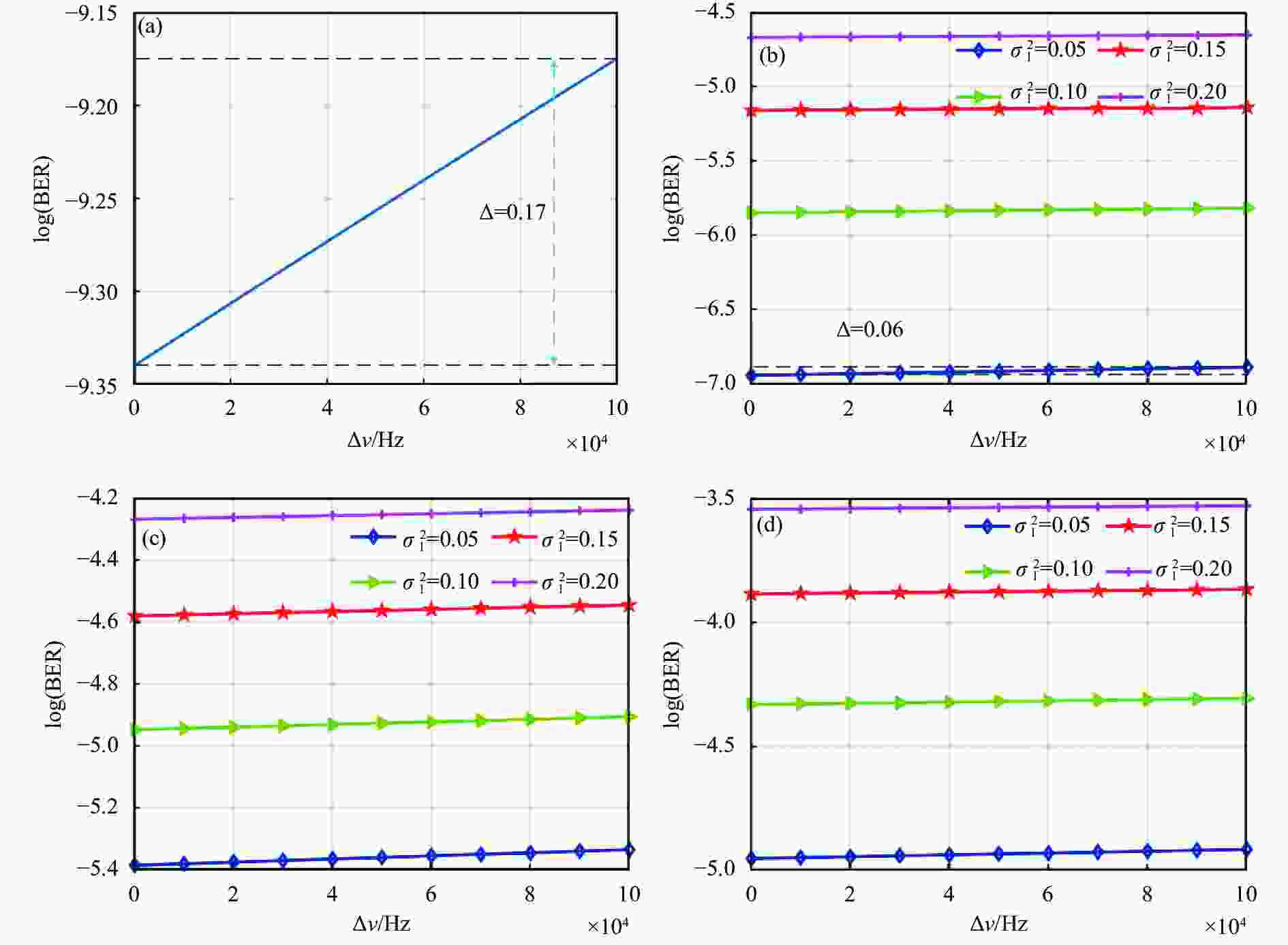
Figure 2. (a) BER of space downlink coherent laser communication systems with narrow linewidth without the effect of atmosphere turbulence; (b) BER under the effect of fluctuations in optical signal intensity caused by atmosphere turbulence; (c) BER under the effect of fluctuations in optical signal phase caused by atmosphere turbulence; (d) BER under the effect of fluctuations in optical signal intensity and phase caused by atmosphere turbulence
为了解大气湍流引起的光信号强度波动对空间下行相干激光通信性能的影响,分析了大气湍流引起的光信号强度波动影响下空间下行相干激光通信系统的误码率,如图2(b)所示。可以发现当大气湍流闪烁方差为0.05时,系统的误码率接近10−7,而当大气湍流闪烁方差0.20时,系统的误码率约为10−4.6,误码率相差超过2个量级,这表明空间下行相干激光通信系统接收端的光强波动对系统性能影响较大,在实际的通信系统中需要注意系统运行时的大气环境。此外,激光器线宽在100 Hz~100 kHz变化范围内,空间下行相干激光通信系统的误码率变化范围小于10−0.06,这表明在大气湍流引起的光强波动的影响下,窄线宽激光器的相位噪声对系统性能的影响更小了。
在以往的大气湍流模型中,不少研究者会忽略大气湍流引起的光信号相位波动。因此,为了探究能否忽略大气湍流引起的光信号相位波动,分析了在大气湍流引起的光信号相位波动影响下的空间下行相干激光通信系统的误码率,如图2(c)所示。和图2(b)相比,在光信号相位波动下系统的性能更差,误码率更大,这说明大气湍流引起的光信号相位波动对空间下行相干激光通信系统误码率的影响大于大气湍流引起的光信号强度波动对系统误码率的影响,光信号相位波动影响下的相位噪声大于光信号强度波动影响下的强度噪声。因此在空间下行相干激光通信系统中,不仅要考虑大气湍流引起的光信号强度波动,更应该考虑光信号相位波动。与图2(b)类似,当激光器线宽从100 Hz~100 kHz变化范围内,空间下行相干激光通信系统的误码率变化范围很小。这表明在大气湍流引起的光信号相位波动下,窄线宽激光器的相位噪声对系统性能的影响很小。
通过上述分析可以发现,在空间相干激光通信系统中,大气湍流引起的光信号相位波动是不可以忽略的,因此在同时考虑了光信号强度波动和光信号相位波动的影响情况下,分析了大气湍流影响下的空间下行相干激光通信系统的误码率,如图2(d)所示。在从图2(d)可以发现,在光信号强度波动和光信号相位波动的影响下,空间下行相干激光通信系统的误码率已经大于10−5了。当大气湍流闪烁方差为0.15时,此时的系统的误码率已经大于10−4了,对于通信系统而言此时的误码率已经较差了。而当大气环境进一步变差时,即大气湍流闪烁方差变大,空间下行相干激光通信系统的误码率会变得更大,这就需要采取纠错等技术才能够实现正常通信。
可以发现在大气湍流的影响线下,一方面,空间下行相干激光通信系统的误码率会变大,在大气湍流闪烁方差为0.05时,系统误码率下降了5个量级,当大气湍流闪烁方差为0.20时,系统误码率下降了6个量级。这表明大气湍流对空间下行相干激光通信系统的误码率影响很大,在实际的通信系统中需要额外注意。另一方面,在大气湍流的影响下,窄线宽激光器线宽对于空间下行相干激光通信系统的误码率的影响减小了。因此,在考虑大气湍流下的空间下行相干激光通信系统性能时,可以不用过于考虑窄线宽激光器线宽的大小,线宽在100 kHz以内都能很好的满足系统性能。
为进一步说明图2(a)~(d)所示现象产生的具体原因,分析了窄线宽激光器下不同大气湍流空间下行相干激光通信系统噪声的比值,见图3(a)~(d)。首先,了解图2(a)所示的在激光器线宽100 kHz范围内,窄线宽激光器的线宽对系统性能影响小的原因,分析了无大气湍流影响下空间下行相干激光通信系统的强度噪声与窄线宽激光器相位噪声的比值,如图3(a)所示。从图3(a)可以发现激光器线宽100 kHz范围内,没有大气湍流影响的强度噪声与窄线宽激光器相位噪声之比大于10 dB,当激光器线宽在10 kHz范围内,没有大气湍流影响的强度噪声与窄线宽激光器相位噪声之比大于20 dB。这表明没有大气湍流影响下,系统中由于窄线宽激光器线宽产生的激光器相位噪声影响相较于系统中强度噪声很小,窄线宽激光器相位噪声在系统噪声中占的比例很小,即激光器线宽在100 kHz范围内对系统性能影响很小。这与图2(a)中当系统的窄线宽激光器线宽从100 Hz~100 kHz的变化范围内,空间下行相干激光通信系统的误码率只变化了10−0.17的结果是一致的。

Figure 3. (a) Ratio of intensity noise to laser phase noise in a space downlink coherent laser communication system without the effect of atmosphere turbulence; (b) The ratio of intensity noise under the effect of atmosphere turbulence to phase noise caused by atmosphere turbulence; (c) Ratio of intensity noise under the effect of atmospheric turbulence to laser phase noise; (d) Ratio of noise under the effect of atmosphere turbulence to the phase noise of the laser
为进一步分析大气湍流引起的光信号强度波动和相位波动对空间下行相干激光通信系统的误码率影响差距的原因,分析了空间下行相干激光通信系统在大气湍流影响下的强度噪声与在大气湍流影响下的相位噪声之比(图3(b)),由此可以发现,大气湍流影响下的强度噪声小于大气湍流影响下的相位噪声,因此在空间下行相干激光通信系统中考虑大气湍流引起相位噪声比只考虑大气湍流引起光强波动情况下的误码率大,这与图2(b)的误码率要低于图2(c)的误码率是一致的。在大气湍流影响下相位噪声对空间下行相干激光通信系统的性能影响更大,因此在实际的空间下行相干激光通信系统中需要更加关注大气湍流引起的接收端光信号相位波动带来的影响。此外,随着大气环境进一步变差,大气湍流闪烁方差增大,大气湍流影响下的强度噪声与大气湍流影响下的相位噪声的比值减小。这说明随着大气湍流闪烁方差的增大,大气湍流影响下的相位噪声在系统噪声中的占比也随之增大。因此当大气湍流闪烁方差较大时,需要额外关注大气湍流带来的接收端光信号相位波动对空间下行相干激光通信系统性能的影响。
此外,先分析大气湍流影响下空间下行相干激光通信系统中窄线宽激光器相位噪声的影响,再分析大气湍流影响下空间下行相干激光通信系统中的强度噪声与窄线宽激光器相位噪声之比(图3(c))。还分析了大气湍流影响下空间下行相干激光通信系统中的强度噪声以及大气湍流引起的相位噪声与窄线宽激光器相位噪声之比(图3(d))。通过对比图3(d)与(c)可以发现,当大气湍流闪烁方差为0.05,激光器线宽分别为100 Hz和102.4 kHz时,图3(d)的值分别为45.35 dB和15.25 dB,图3(c)的值分别为42.50 dB和12.40 dB,两者都相差2.85 dB。当大气湍流闪烁方差为0.20,激光器线宽分别为100 Hz和102.4 kHz时,图3(d)的值分别为46.83 dB和16.73 dB,图3(c)的值分别为42.84 dB和12.74 dB,两者都相差3.99 dB。这表明在考虑了大气湍流引起接收端光信号相位波动之后,大气湍流影响下的噪声与激光器相位噪声的比值会升高3 dB左右。而且随着大气湍流闪烁方差的增大,比值升高的越大。此外,图3(d)与(a)相比,可以发现,线宽为100 Hz时,没有大气湍流影响下强度噪声与窄线宽激光器相位噪声之比为41.07 dB,而在大气湍流影响下,当大气湍流闪烁方差分别为0.05和0.20时,图3(d)中的比值分别为45.35 dB和46.83 dB,分别增大了4.28 dB和5.76 dB,这表明在大气湍流的影响下,窄线宽激光器由于线宽导致的相位噪声在系统噪声中的比值更小了,这与图2(a)和图2(d)在大气湍流的影响下,窄线宽激光器线宽对于空间下行相干激光通信系统的误码率的影响减小了是一致的。
在相干激光通信系统中,通信性能对通信速率比较敏感,这也意味着不同通信速率下激光器线宽对系统性能影响不同。图4(a)~(d)分别为通信速率为100 Mbps、1 Gbps、2.5 Gbps以及10 Gbps时,不同大气湍流下空间下行相干激光通信系统的误码率。可以发现随着通信速率的增加,系统的误码率会上升,系统性能下降。通信速率为1 Gbps,大气湍流闪烁方差为0.05和0.10时,系统的误码率较好,可以维持10−6以下,此时较为适合通信,能满足大多数通信需求。而在高速通信速率下,如图4(d)所示的10 Gbps时,空间下行相干激光通信系统的误码率已经接近10−2了,此时系统的通信性能很差,已经无法正常通信。此外对于低速的通信系统,图4(a)中的100 Mbps通信速率时,此时激光器线宽对系统性能影响较大,在100 kHz的激光器线宽范围内,系统性能变化明显,误码率变化了10−2~10−3。而随着系统通信系统速率的增加,窄线宽激光器的线宽对系统性能的影响越来越小。当通信速率为10 Gbps时,窄线宽激光器的线宽对系统性能已经几乎没有影响。
-
文中基于QPSK通信系统的原理,在QPSK通信系统中引入了窄线宽激光器的相位噪声、大气湍流引起的光信号强度和相位波动,得到空间下行QPSK通信系统误码率模型。在此基础上,分析和讨论了不同大气湍流下窄线宽激光器对空间下行相干激光通信系统性能影响,以及不同通信速率下窄线宽激光器对空间下行相干激光通信系统性能影响。
仿真结果表明在大气湍流的影响下,空间下行相干激光通信系统的通信性能会减弱,在大气湍流闪烁方差分别为0.05和0.20时,系统误码率分别下降了5和6个量级。这表明大气湍流对空间下行相干激光通信系统的误码率影响很大,在实际的系统设计中需要额外关注大气信道的影响。大气湍流引起的光信号相位波动与大气湍流引起的光信号强度波动对空间下行相干激光通信系统的误码率影响相比,前者影响更大,这主要是因为光信号相位波动引起的相位噪声要大于光信号强度波动影响下的强度噪声。因此在空间下行相干激光通信系统中,不仅要考虑大气湍流引起的光信号强度波动,更应该考虑光信号相位波动。此外,在大气湍流的影响下,100 kHz范围内的激光器线宽对于空间下行相干激光通信系统的误码率的影响更小,因此在设计空间下行相干激光通信系统时,可以不用过于关注激光器线宽的大小,100 kHz范围内的激光器线宽都能较好地满足系统设计需求。最后,还发现空间下行相干激光通信系统在不同的通信速率下系统的性能差异较大,随着通信速率增大,激光器线宽对于系统性能影响越小。文中的研究结果对于采用窄线宽激光器的空间下行相干激光通信系统的设计和调试具有一定的意义。
Investigation of the effect of narrow linewidth lasers on performance of coherent communication systems under atmosphere channels
doi: 10.3788/IRLA20220219
- Received Date: 2022-04-15
- Rev Recd Date: 2022-05-20
- Publish Date: 2023-01-18
-
Key words:
- space coherent laser communications /
- bit error rate /
- atmosphere turbulence /
- narrow linewidth laser /
- phase fluctuations
Abstract: In space downlink coherent laser communication systems, the laser linewidth will affect the performance of the communication systems. The narrow linewidth laser can effectively reduce the laser phase noise caused by the laser linewidth and is the prime preference for present-day coherent laser communication systems. When optical signals are propagated in atmosphere channels, atmosphere turbulence will cause optical signals strength and phase fluctuations, which further affects the communication performance of the system. In response to the above problems, this manuscript derives the BER model for space downlink Quadri Phase Shift Keying (QPSK) communication system based on the principle of the QPSK communication system and further considered the linewidth of narrow linewidth laser, the fluctuation of optical signal intensity and phase fluctuations caused by atmosphere turbulence. Based on this model, the effect of narrow linewidth laser on the performance of space downlink coherent laser communication system under different atmosphere turbulence and communication rates is analyzed by numerical simulation. The results show that atmosphere turbulence not only severely affects the system performance but also weakens the effect of laser linewidth on the system performance. And the phase fluctuations caused by atmospheric turbulence have a greater effect on system performance than the light intensity fluctuations they cause. In addition, as the communication rate increases, the performance of the system decreases, and the laser linewidth has a reduced effect on the system performance. This paper has the practical reference for the optimal design and adjustment of space downlink coherent laser communication systems.



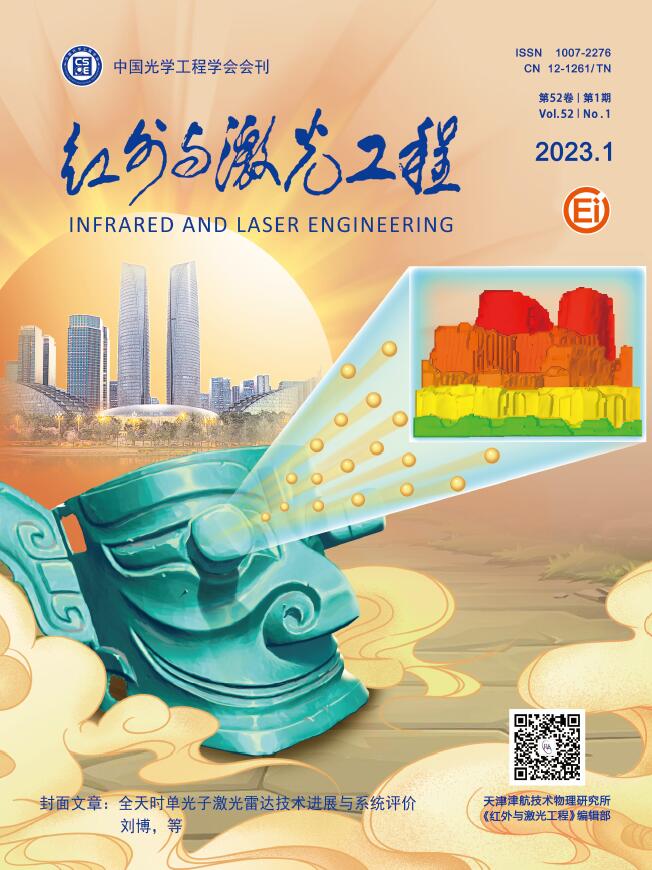





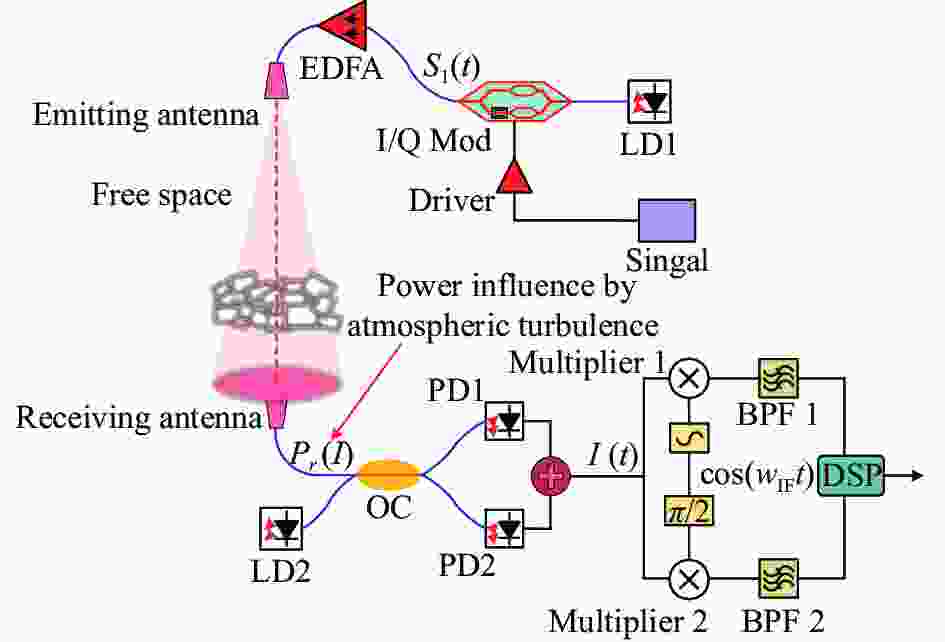














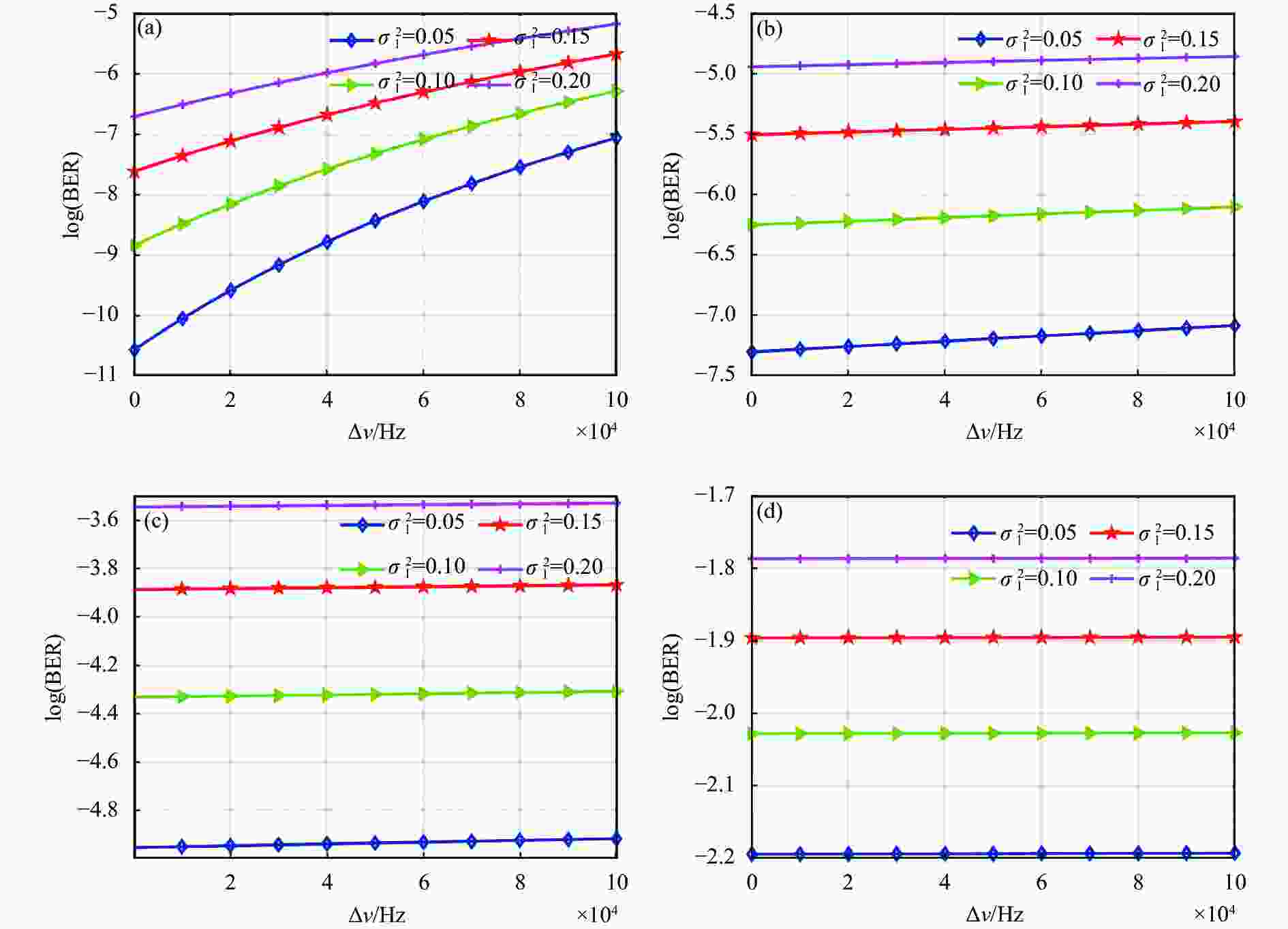

 DownLoad:
DownLoad:
